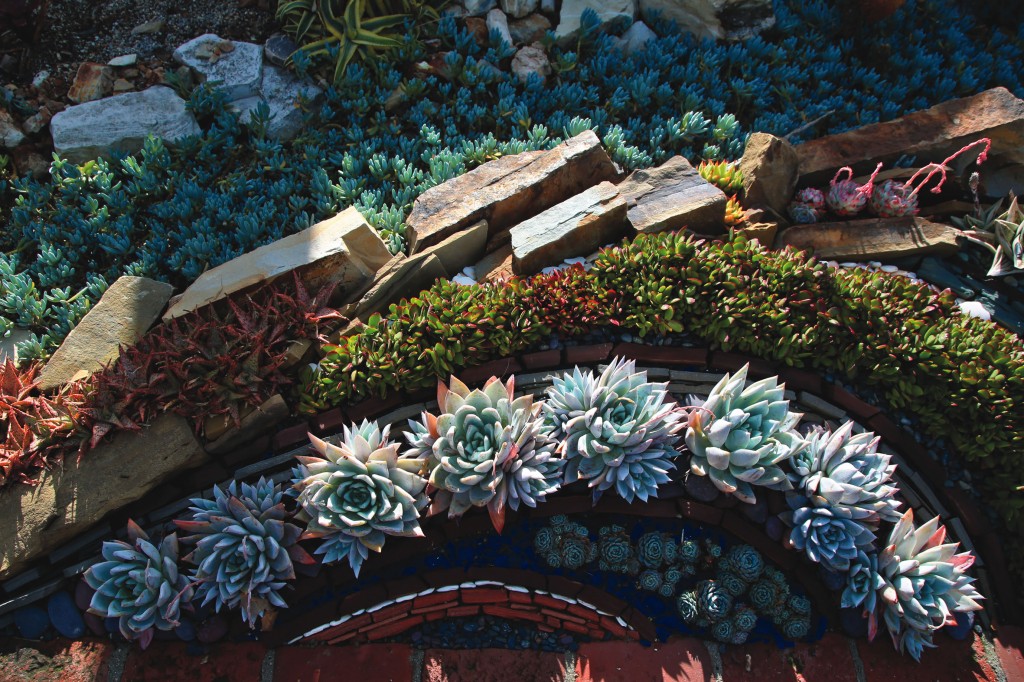Native plants and sustainable methods help the environment while saving homeowners time and money.
By Sharon Stello | Photos by Jody Tiongco
Not a single blade of grass grows in Wayne and Shannon Inouye’s front yard. Instead, the space features a dry creekbed of stones curving across a swath of redwood chips, punctuated by spikes of bright green yucca and small shrubs sprouting pink and purple flowers. Butterflies can often be found darting from blossom to blossom.
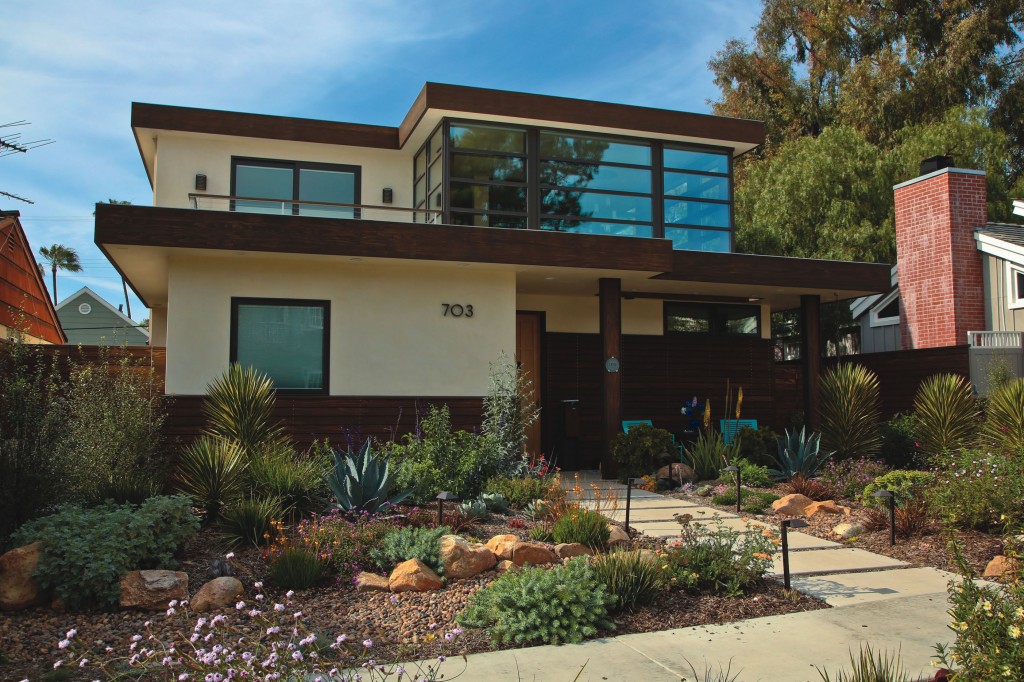
This Corona del Mar yard was built in a sustainable style to match the Inouyes’ LEED Platinum-certified house, which is one of about 2,200 single-family homes in the world given this designation by the nonprofit U.S. Green Building Council for meeting high standards in environmental design. The garden—designed by Sarah Robinson from The Plant Nerd in Huntington Beach—won last year’s California Friendly Garden Contest, a countywide competition sponsored by Roger’s Gardens, a family-owned Corona del Mar home and garden store.
For Shannon, it was an easy decision to build a home and garden with less impact on the environment. “Our planet is being damaged by our current practices and we need to be proactive in our actions to improve things,” she explains.
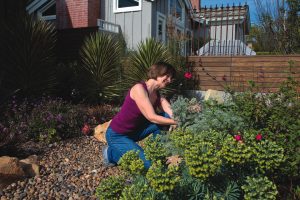
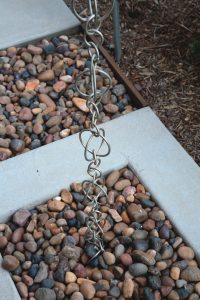
A trend that goes hand in hand with the organic food and healthy living movements, sustainability as an approach to gardening has received a green thumbs-up as it’s less expensive to maintain and requires a smaller time investment, according to Ron Vanderhoff, general manager of Roger’s Gardens. When Ron started working in the gardening business 35 years ago, he says no one cared about sustainable practices besides a niche minority. In recent years, especially in times of drought like this one, the trend is moving away from the lush lawn—which Ron calls “a poster child for nonsustainable landscape”—and toward plants that thrive with less water.
Sustainable Steps
While most people who consider creating a sustainable garden don’t eradicate the entire lawn like the Inouyes, more homeowners are taking steps in the “green” direction. Yard renovations today incorporate some eco-friendly elements, whether it’s less turf, solar lights or native plants, which grow in the region naturally.
“You can take a traditional garden and do things in a sustainable way,” says Scott LaFleur, garden director of Sherman Library & Gardens in Corona del Mar, explaining that homeowners can move in a sustainable direction by simply changing their current methods. Watering, for instance, can make all the difference.
“Most people are way overwatering everything,” Scott says, noting that sprinkler timers need to be adjusted seasonally. “[People] set it and forget it.”
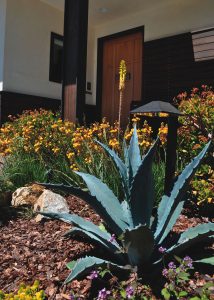
One option for water control is to install weather-sensitive irrigation controllers, which shut off when it rains. Newport Beach residents who choose to install weather-based irrigation controls—in addition to rotating sprinkler nozzles, soil moisture sensors and rain barrels—can receive rebates from the Metropolitan Water District of Southern California with an accepted application. To further reduce water bills, irrigate in the early morning or evening—not during the heat of the day when much of the water is lost to evaporation. Likewise, plant beds should be covered with organic mulch such as bark chips to reduce evaporation and runoff.
Scott also encourages homeowners to compost lawn clippings and plant trimmings and then apply that rich material to the soil to give it a natural boost. He advises staying away from artificial fertilizers because the plants become dependent on these additives, which kill the living organisms that help a garden flourish.
“It’s kind of like putting your plants on drugs,” Scott says of synthetic fertilizers. “… [Instead,] you want to try to create balance in the ecosystem.”
Making a yard environmentally friendly is not an all-or-nothing proposition, however. “Sustainable gardening is a degree—it’s a gray area,” Ron explains, defining a sustainable garden as one having fewer inputs and outputs. Inputs include money, time and energy; water and other natural resources; chemicals such as fertilizer and insecticides; and fuel or electricity to run lawn mowers and edgers. Outputs include garden clippings and other green waste; water runoff carrying chemicals to storm drains and the ocean; and pollution from leaf blowers and lawn mowers.
“If you can reduce [all of] those … you’re getting closer to a sustainable garden,” Ron says.
When switching to sustainable, Ron and Scott both recommend taking small steps—adding one or two native plants, such as lavender or sage—or removing a small portion of lawn and becoming comfortable with those changes before embracing more eco-friendly elements.
“People look at converting their garden to sustainable and become overwhelmed,” Ron says. “My approach is just change 10 percent; just get started. Don’t worry about changing things all at once. Take the lawn down a few feet or, when buying a replacement plant, buy one that’s a little more climate appropriate.”
Eco-Friendly Flora
Coastal Southern California’s mild winters and summers can support thousands of plants, particularly Mediterranean varieties and—a subset of those—California native plants. Cactuses and other succulents also flourish, adding interesting shapes and textures to gardens.
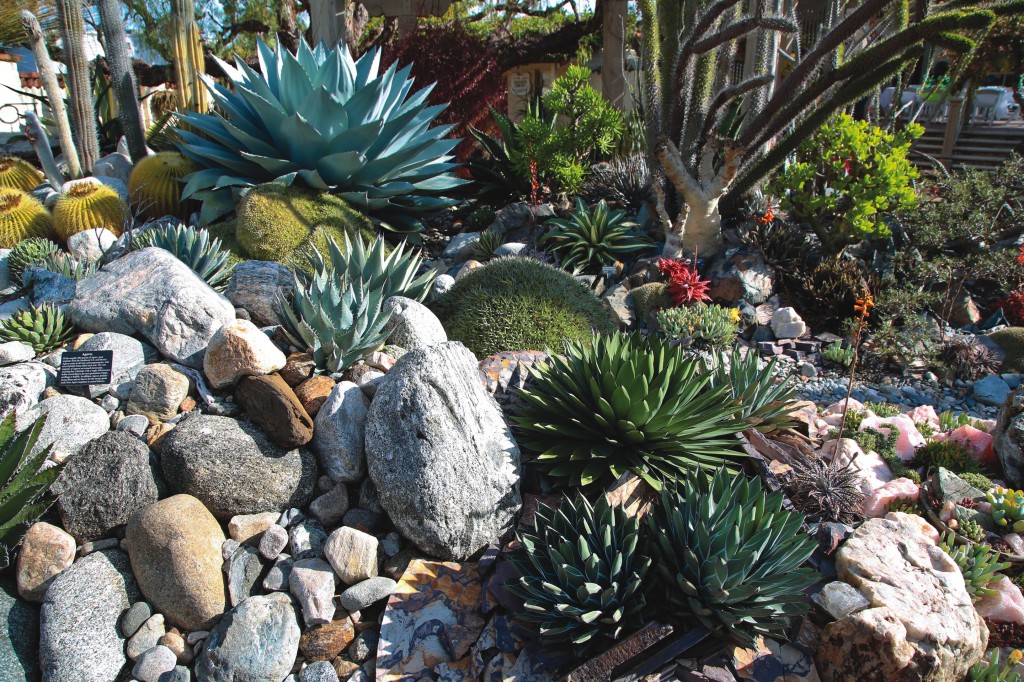
Such plants are viable options for homeowners who wish to dedicate their time to activities other than mowing and weeding every weekend. At the Inouye home, Shannon says she values the reduced maintenance of her sustainable garden because it saves both time and money by allowing succulents and native plants, such as sagebrush, salvia, monkey flower and yarrow, to thrive on their own.
Serving more than one purpose, native plants provide food and habitat for butterflies and birds, according to Scott, who knows a thing or two about native plants. He took the helm of Sherman Gardens in January after serving as director of horticulture at Rancho Santa Ana Botanic Garden in Claremont, which boasts the largest collection of California native plants.
In his new role, Scott plans to expand Sherman Gardens’ native plant area as a resource for community members to learn about sustainable gardening. “It’s definitely something we are going to start doing more of,” Scott says. “It’s not the plant—it’s how you use the plant in design and it’s how you’re interacting. It’s finding that sweet spot between economics and aesthetics.”
Perfect Presentation
Like the Inouyes did for their garden, Ron suggests choosing drought-tolerant plants that remain attractive no matter the season. “Choose those that have beautiful, year-round interest,” he says. That could mean a plant that keeps its green foliage or features bright flowers in spring or berries in winter.
When putting together a sustainable garden, sometimes it takes a designer’s plant knowledge and artistic eye to make it flow in a way that works and is aesthetically pleasing.
“Every element has to tie into each other,” says Warwick Hunt, principal designer and founder of Studio H Landscape Architecture, which has an office on Balboa Peninsula. For example, it’s important to group plants based on their needs for water, light and soil. Certain plants need a designated amount of space between others or else everything around it may soon be squeezed out or hidden in shade.
“That’s where an expert can help,” Ron says.
For landscape inspiration, Sherman Gardens features an impressive array of succulents in creative layouts, a big part of making a garden inviting.
Warwick notes that sustainable gardens extend beyond plants to the lighting and building materials used for patios. He tries to incorporate sustainable elements, from drip irrigation to LED lights, in his projects. “We try to explain that the extra $35 per light fixture will pay for itself and it’s a better product,” Warwick says.
For decks, he steers homeowners to ipe, a sustainable Brazilian hardwood that is certified by the Forest Stewardship Council—an organization that promotes responsible management of forests such as replacing trees every time one’s cut down. “It’s a very hard wood and it’s long-lasting and has a nice, dark, rich color to it,” he explains.
When choosing stone, Warwick opts for limestone from quarries in the U.S. rather than Asia to reduce the cost and carbon footprint. He also recommends Carlsbad-based Oceanside Glasstile for tiles made in part with recycled glass bottles.
While some clients may not be thinking about the environment when they begin a garden project, Warwick tries to educate them about eco-friendly options. “I just try to open their eyes [to] … a great product,” he says. “[They] can save some money and it looks as good or better. It’s an easy sell.”
While sustainable design is still a low percentage of his firm’s work, he says more clients are seeking this kind of landscaping every year: “It’s definitely going in the right direction.”
With a sustainable mindset, a palette of native plants and better-for-the-environment materials, any garden can go green with minimal effort. And for those ready to make a bold move, there’s always the option of ditching the lawn altogether. NBM


